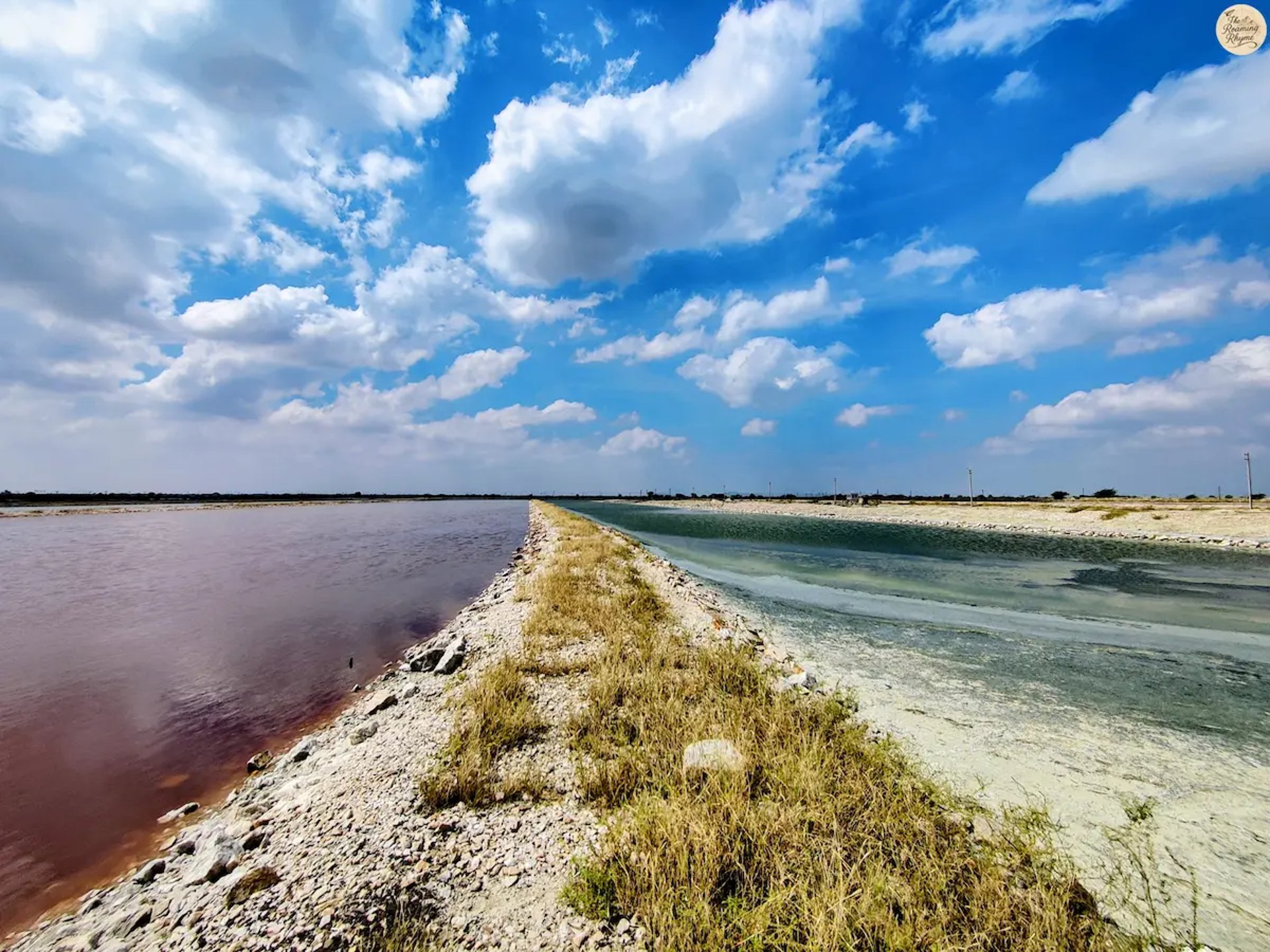
Sambhar Salt Lake – The White Wonderland of Rajasthan
Discover the lake’s charm, history, and all you need to plan your perfect trip.
Sambhar Salt Lake – India's Hidden White Wonder
Just a few hours from Jaipur, the desert begins to dream — and the land turns white. Here lies Sambhar Salt Lake, India’s largest inland salt lake, a mirror of the sky and a mystery of earth. Locals call it the White Wonder of Rajasthan — some even whisper it’s India’s answer to Bolivia’s Salar de Uyuni.
Spread across the meeting lines of Jaipur, Nagaur, and Ajmer, this Rajasthan salt lake stretches nearly 35–40 km around its vast, gleaming rim. From a distance, it feels endless — a horizon melting into a mirage of light and salt.
But Sambhar isn’t just a vision; it’s the Salt Heart of India, producing nearly 10% of the country’s salt through age-old evaporation methods. What looks like snow under the sun are salt sheets — cracked, glistening, alive with the shimmer of heat.
There’s a rhythm to this white silence. No trees. No city hum. Just the whispering wind and the crunch of salt beneath your steps. Some say it mirrors the Rann of Kutch, yet Sambhar Lake Rajasthan holds its own soul — raw, real, and irresistibly photogenic.
From Pre-Wedding Shoots to Offbeat Road Trips near Jaipur, the lake draws dreamers and wanderers alike. In winter, flamingos tint the water soft pink, while monsoon paints surreal reflections across the salt pans of Sambhar. By night, under a thousand stars, it feels otherworldly — a place where peace, wonder, and disbelief dance together on the white stage of Rajasthan.
Updated on: 17th, Oct 2025
Explored on: Sept' 2025
How to Reach Sambhar Salt Lake
Getting to Sambhar Salt Lake is as easy as it is scenic — no matter which way you travel. Located about 80 km from Jaipur and 190 km from Ajmer, it makes for the Perfect Day Trip or Weekend Getaway from the Pink City. Each route has its own charm — from open highways to dusty trails that end where the earth turns white.
By Air
The nearest airport is Jaipur International Airport, around 90 km away from Sambhar Lake. From there, hire a cab or rent a self-drive car — the drive from Jaipur to Sambhar Salt Lake takes about two hours. As you leave the city behind, the roads slip through quiet Rajasthani villages, mustard fields, and open desert plains — until the white shimmer of the salt pans greets you on the horizon.
By Train
You can also easily reach by train to Sambhar Salt Lake Railway Station, well connected to Jaipur, Ajmer, and Jodhpur. From Jaipur, it’s just about an hour’s ride on local or express trains. Once there, autos or local cabs can take you to the lake viewpoint, salt pans, or Sambhar town itself — a short, soulful detour into Rajasthan’s saline heart.
By Road
A road trip from Jaipur to Sambhar Lake is the most popular and photogenic choice. Take NH48 and Dudu–Sambhar Road — a smooth, open stretch that feels made for riders and wanderers. The journey takes around two hours from Jaipur or two and a half from Ajmer or Pushkar. It’s a route where the desert hums. Where offbeat Rajasthan reveals itself — raw villages, endless skies, and sudden bursts of white horizons. As you near the lake, the land softens, the air turns saltier, and the vast white wonder of Sambhar begins to shimmer like a mirage — calling you closer with every mile.
Best Time to Visit Sambhar Salt Lake
The magic of Sambhar Salt Lake shifts with every season — each month paints the white desert in a new shade of wonder. Whether you seek reflections, flamingos, or cracked salt beds, every visit feels like a different poem written on Rajasthan’s salt canvas.
Winter (October – March)
The best time to visit Sambhar Salt Lake is winter. The weather stays cool and calm, and the salt plains glow like silver under gentle sunlight. This is when flamingos and migratory birds arrive in thousands, turning the horizon into a soft pink dream. It’s paradise for photographers, bird lovers, and couples — a season of calm skies, mirror glows, and endless walks across the white expanse
Monsoon (July – September)
During the monsoon, the Sambhar Salt Lake partly fills with rainwater, transforming into a natural mirror of the sky. Clouds drift across its surface, reflections shimmer with every breeze, and the surrounding Rajasthani landscape looks fresh and alive. It’s a great time for road trips and scenic drives — when the lake hums softly and the desert feels reborn.
Summer (April – June)
Summer brings heat — and beauty of another kind. The salt beds crack and ripple, forming surreal patterns that photographers love. This is the offbeat season for adventure seekers, when you can walk across the exposed lake bed and capture its raw, geometric textures. If you can bear the sun, the reward is silence — and the sight of Rajasthan’s white desert stretching endlessly around you.
Most travelers visit Sambhar Salt Lake as a day trip from Jaipur, Ajmer, or Pushkar, but staying overnight lets you truly feel its rhythm — the hush of dusk, the salt glow at sunrise, and the stars spilling across the desert night. Today, Sambhar offers a growing mix of heritage stays, boutique retreats, lakeside tents, and budget hotels — each adding its own shade to this white wonderland of Rajasthan.
Sambhar Heritage Resort – Luxury & Boutique Stays
The Sambhar Heritage Resort operates three distinct properties, each telling a story of its own — from colonial charm to lakeside calm.
Circuit House – Built in 1880, this colonial-era heritage stay near Sambhar town stands quietly by the Sambhar Salts facility. With high ceilings, thick walls, and even a vintage hand-operated lift, it offers old-world grace wrapped in silence. While it doesn’t overlook the lake directly, it breathes nostalgia — perfect for travelers seeking history and heritage near Sambhar Salt Lake.
The Kothi – Once a British clubhouse, now transformed into a cozy boutique stay, The Kothi shares facilities with the Circuit House. Here, colonial design meets Rajasthani warmth — ideal for those who love comfort with a story.
Swiss Tents at Jhapok – If you dream of waking up to the white expanse, this is your stay. Set near Jhapok, on the way to Shakhambari Devi Temple, the Swiss Tents overlook the shimmering salt lake plains. By day, they open to silence and salt; by night, to a thousand stars. Perfect for photography, stargazing, or simply breathing in the stillness of Rajasthan’s white desert.
Camp Sambhar – By Alcor
For travelers seeking something wilder, Camp Sambhar by Alcor offers tented accommodations near the lake.
Perched on stilts, it’s not rough camping — but a comfortable adventure stay where you can feel the breeze, walk to the lake edge, and wake up to flamingo silhouettes in the dawn light.
Other & Budget Options
Budget travelers will find several guesthouses and small hotels in Sambhar town and along the road to Shakhambari Devi Temple.
These simple yet welcoming stays provide easy access to the salt pans, railway track viewpoints, and local eateries — ideal for those exploring offbeat Rajasthan on a modest budget.
Where to Stay in Sambhar Salt Lake
History and Legends: A Legacy Etched in Salt
The story of Sambhar Salt Lake runs deep — as deep as its white, glimmering bed. It’s a tale carved in salt, drifting through myth, trade, and time, where every grain carries echoes of empires and gods.
The name Sambhar comes from “Sambhara”, a Sanskrit word for salt — a perfect name for this land of white gold that has shone for over 5,000 years. Archaeologists believe the Indus Valley Civilization once extracted salt here, making Sambhar one of the oldest salt production sites in the world. By the Mauryan era (3rd century BCE), it had already grown into a thriving salt trade hub of Rajasthan, its wealth carried across kingdoms by camel caravans.
As time drifted on, Rajput dynasties — from the Chauhans to the Mughals — claimed Sambhar as their salt jewel. They taxed its trade, guarded its shores, and wrote its name into royal ledgers. Under Jahangir, salt leases were formalized, and later, the British Empire turned Sambhar into a colonial asset, founding Sambhar Salt Limited in 1884. They even built a Narrow-Gauge Railway Line across the lake, a whispering relic that still glints under the desert sun — steel crossing salt, ambition crossing time.
Yet the true soul of Sambhar is not in its trade — it’s in its Legends.
Locals tell of Maa Shakambari Devi, guardian goddess of the Chauhans, who once blessed this land with forests of jewels. When greed overtook gratitude, she transformed those gems into salt, turning desire into humility. Her temple still crowns the hill near Sambhar Lake, and every August, during the Shakambari Mata Fair, faith and color sweep across the white plains in her honor.
And older still is the Mahabharata’s whisper.
It is said that King Yayati, ancestor of the Pandavas and Kauravas, once ruled this region.
His tale — of love for Devyani and longing for Sharmishtha — is one of pride, desire, and divine consequences. Even today, Devyani Kund and Sharmishtha Sarovar near the lake are believed to mark the sacred chapters of his story — where myth meets mirror, and time stands still over the white salt of Sambhar.


Endless white plains, horizon melts away,
Salt sparkles gently, soft winds play.
Shakambari stands, silent and bright,
Ripples kissed by sunlight, claim in sight.
Flamingos gather, painting the white,
Open roads call, wheels chasing light.
Stars spill like diamonds, nights draped in silver,
Trolleys glide slowly, time seems to shiver.
Salt pans glint, a story untold,
Generations' hands shaping the White-gold.
Heritage town streets, Feeni in hand,
Colonial roofs watch over the land.
Kunds hold legends, love in their flow,
Naliasar hums of the past we know.
Desert skies trace paths sublime,
Every breeze hums the roaming rhyme.
Sambhar is more than a salt lake — it’s a living canvas where calm meets color and silence hums with stories. Here, every moment feels suspended between earth and sky — from the shimmer of salt pans to the echo of ancient legends at Devyani Kund and Sharmishtha Sarovar. The heritage town of Sambhar still carries whispers of its royal past and archaeological trails at Naliasar, while flamingos sweep across pink horizons in winter light. You can ride a salt trolley, camp under the stars, taste local Feeni, or simply wander through stillness that sparkles like crystal.
At Sambhar, time slows, colors fade to white, and wonder finds its voice — in every crunch of salt, every reflection, every breath of desert wind.
Things To Do Around Sambhar Lake
Rising from the southern edge of Sambhar Salt Lake, Shakhambari Devi Temple is where faith, legend, and landscape converge in quiet grace. Dedicated to Maa Shakhambari, an incarnation of Goddess Durga and the Kul Devi of the Chauhan Rajputs, the temple radiates timeless reverence and spiritual charm.
Perched under a rocky outcrop about 15 km from Sambhar town, the shrine overlooks the endless white plains — the very land the goddess is said to have transformed from forests into salt. From its steps, the lake stretches like a silver mirror, glimmering beneath the Rajasthan sun.
A short climb up the newly built staircase leads to a cenotaph above the temple, reportedly built by Emperor Jahangir. From here, you can enjoy one of Sambhar’s finest sunrise and sunset views, taking in 360° panoramas of salt mounds, trolleys crossing the flats, and the vast white horizon.
During the Bhado Sudi Ashtami fair, the temple comes alive — pilgrims fill the air with devotion, songs, and colors, celebrating the goddess in a vibrant display of faith. Even on quieter days, Shakhambari Devi whispers her stories through the desert wind — tales of creation, humility, and the eternal bond between the divine and the shimmering salt plains of Rajasthan.
And if the legends of Rajasthan’s Kul Devis fascinate you, travel west to Mehrangarh Fort in Jodhpur, where the Chamunda Mata Temple, revered by the Rathore Rajputs, stands as another powerful symbol of protection and faith.
Shakhambari Devi Temple – The Spiritual Heart of Sambhar

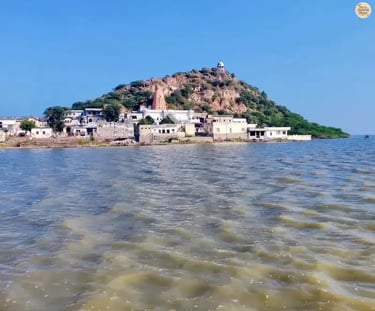
Shakhambhari Devi Temple overlooking the tranquil waters of Sambhar Lake.
Bhairav temple standing alone on an island in Sambhar Salt Lake.
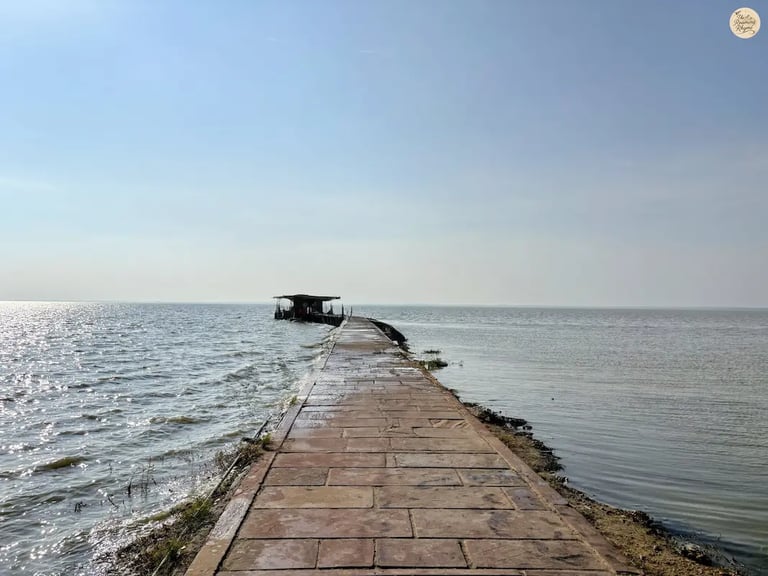

Winter turns Sambhar Salt Lake into a pink paradise. From October to February, thousands of migratory birds arrive from Siberia, Central Asia, and beyond, transforming the white salt expanse into a living canvas.
The true stars are the Greater and Lesser flamingos, whose rose-tinted reflections shimmer across the salt flats. Watching them gather at sunrise or sunset feels surreal — a moving painting of pink and white, where sky and earth seem to merge.
Beyond flamingos, the lake hosts a rich mix of avian life: Black-Winged Stilts, Redshanks, Avocets, Sandpipers, Coots, and Plovers. In the surrounding scrublands, keen eyes may spot Indian Coursers, Black Ibises, and Sandgrouse, while foxes, jackals, and blue bulls occasionally wander the edges, adding a hint of wilderness to the scene.
For birdwatchers and wildlife photographers, this Ramsar-Listed Wetland is a dream. Binoculars and a good zoom lens are all you need — the rest is nature’s symphony, performed across the shimmering salt plains of Rajasthan.
Birdwatching – A Symphony in Pink and White
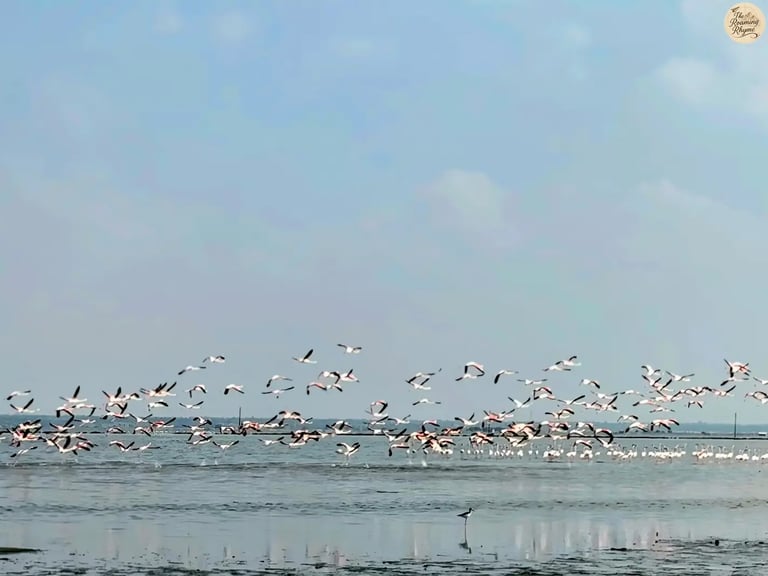



Pink flamingos in flight over Sambhar Lake.
Flamingos flocking over Naliasar Lake near Sambhar, reflecting pink hues on historic waters.
Driving & Adventure – Roads That Vanish Into White
For those who crave the open road, Sambhar Salt Lake is a dream come true. Driving here feels like gliding along the edge of the sky — white salt beneath your wheels, blue horizon ahead, and silence humming like a song.
The smooth trails from the Sambhar salt facility to Shakhambari Devi Temple are perfect for self-drive cars, bikes, and cinematic road trips, offering endless vistas that feel almost otherworldly.
Thrill-seekers can occasionally join ATV Rides, Jeep Parasailing, and Cycling Tours organized by operators from Jaipur, turning the vast, calm lakebed into a playground for adventure.
💡Pro Tip: After monsoon, avoid venturing too deep — the salt crust may appear solid but can be soft underneath. Always drive light, stay on marked tracks, and explore safely to enjoy this surreal landscape worry-free.
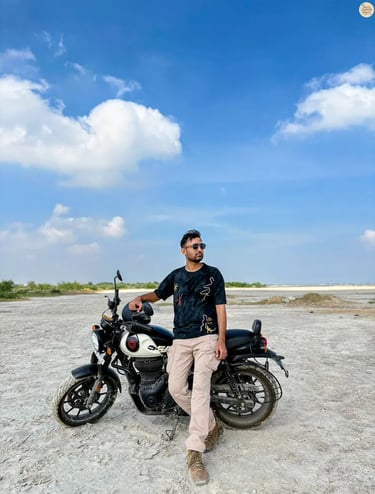



Expansive white salt plains of Sambhar Lake, resembling Rann of Kutch.
posing on a railway track stretching across Sambhar Lake’s salt pans.
Camping & Stargazing – Nights Draped in Silver
When the sun dips below the horizon, Sambhar Salt Lake transforms. The salt glimmers softly under moonlight, and the sky spills stars like diamonds across the desert night.
You can camp near the lake (with permission) or stay at Camp Sambhar – by Alcor, where comfort meets the calm of the white plains. Evenings are best around a bonfire, with glowing embers and the wind tracing the salt flats, whispering secrets of the night.
For stargazers and astrophotographers, Sambhar is a dream. On clear nights or full moons, the salt bed mirrors the Milky Way, creating a surreal canvas of light and reflection. Bring a tripod, patience, and wonder — the rest is pure magic.
And if starlit skies and riverside camps call to your soul, head to Shnongpdeng in Meghalaya, where camping by the Umngot River offers another unforgettable experience — crystal-clear waters by day and a sky full of stars by night.
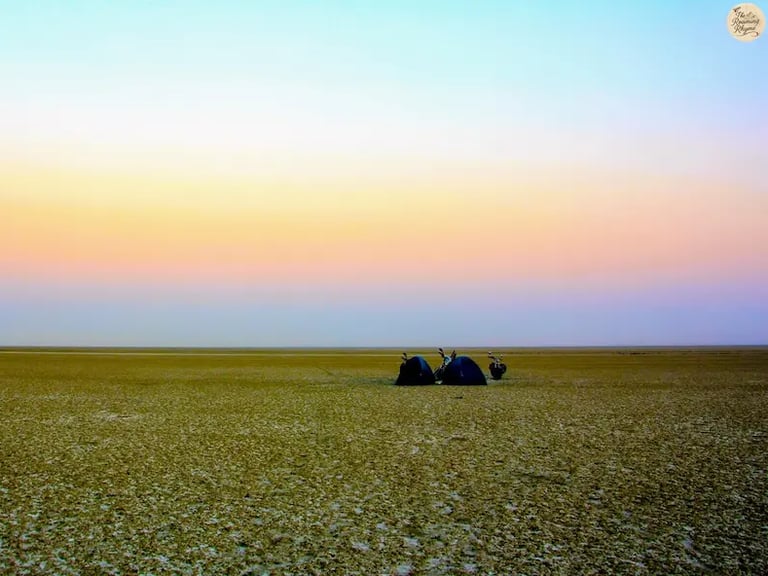

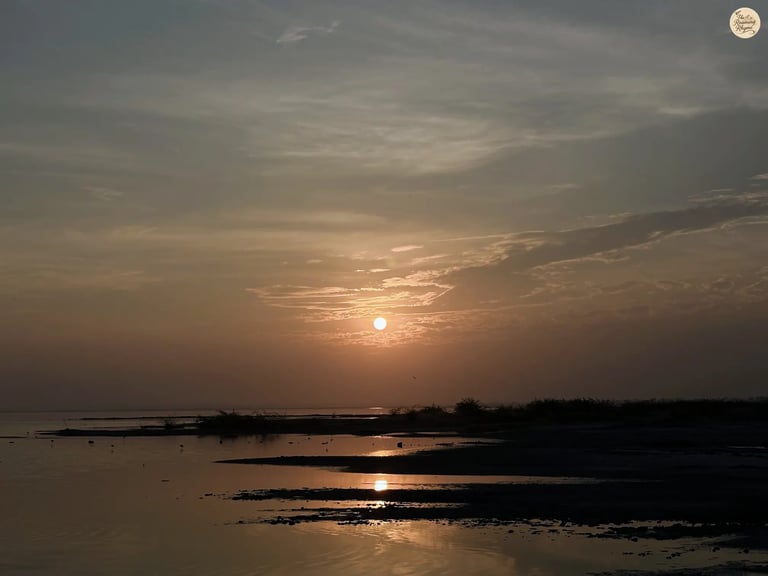

Camping on the white salt bed of Sambhar Lake at twilight.
Experience a Salt Voyage – The Trolley Ride Across White
A journey across Sambhar Salt Lake is not complete without a ride on its Historic Narrow-Gauge Train. This small train, with 2–3 wagons, runs at specified times from the boarding point near Sambhar Heritage Resort tents at Jhapok, offering travelers a chance to experience the vastness of the lake and observe the traditional salt production up close.
Reminiscent of India’s colonial-era railways, narrow-gauge trains like this are rare today, making the ride a step back in time. As you glide along the silver salt flats, the rhythmic movement of the train blends with the quiet shimmer of the landscape, creating a serene journey where time seems to slow down. Part nostalgia, part wonder, this train ride across Sambhar Lake is a unique adventure — entirely immersive and unmistakably Sambhar.


Heritage narrow-gauge train crossing Sambhar Lake at sunrise, bathed in golden light.
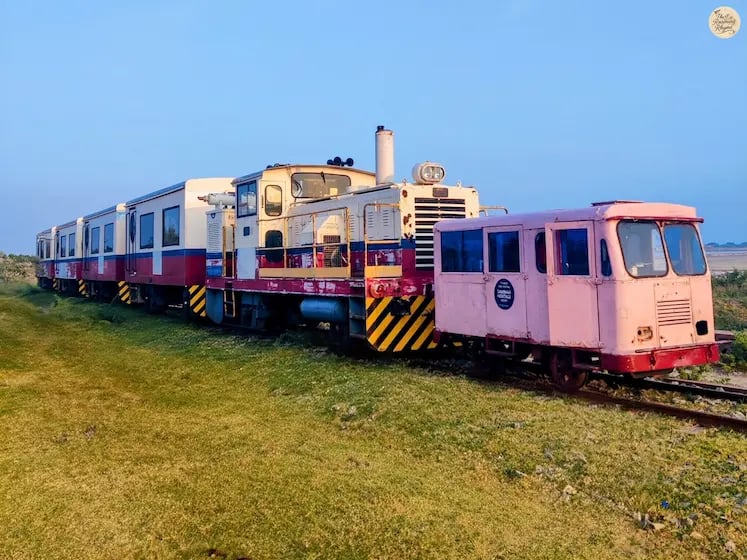

Heritage narrow-gauge train of Sambhar Lake.
Sambhar Salt Museum & Processing Plant – A Journey Through White Gold
On the eastern edge of Sambhar Salt Lake, beyond the 5.1 km sandstone dam, lies a sprawling expanse of ancient salt pans, some over 1,000 years old. Narrow ridges divide these pans, fed by salt-rich waters from the 5,700 sq km catchment of the Mendha and Rupangarh rivers. A colonial-era railway snakes alongside, linking the town of Sambhar to this Historic Heart of India’s Salt Heritage.
Visiting the Sambhar Salt Museum and processing plant offers a rare glimpse into centuries of craftsmanship. Operated by Sambhar Salt Ltd, a unit of Hindustan Salts Ltd, the facility is India’s only central government enterprise dedicated to salt production. Here, you can watch salt-wagering wagons glide across glistening pans, observe the traditional extraction process, and explore the Salt Museum, which houses samples from across the country in a charming colonial-era building.
Some parts of the facility date back to British colonial times, making it not just a working salt processing plant but also a window into the lives and labor of generations who have transformed this white desert into India’s “White Gold.” Walking among the pans, with sun glinting on salt crystals, you can feel the rhythm of history, industry, and nature intertwined across Sambhar Salt Lake.
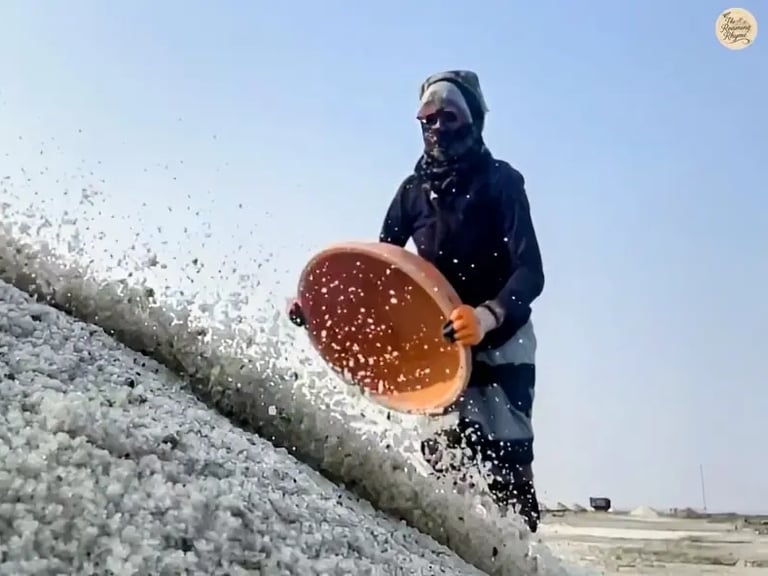

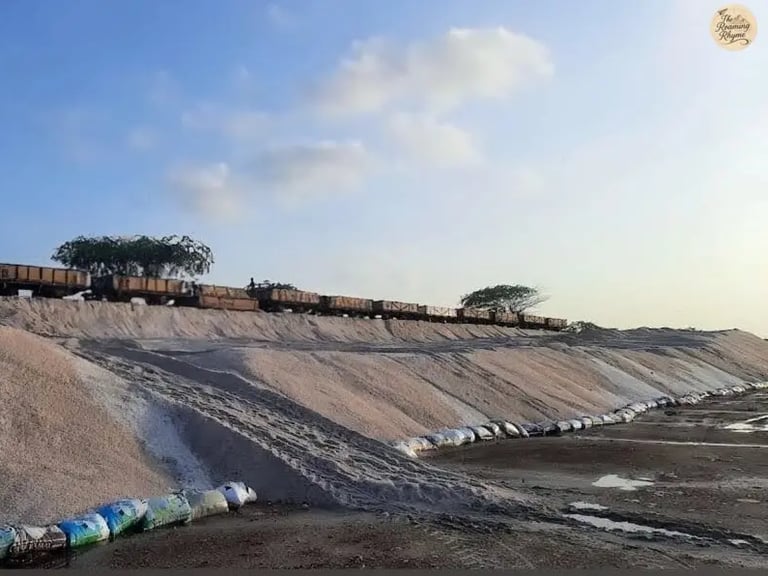

Trolley train carrying raw salt across the Sambhar Salt Lake pans.
Heritage Town of Sambhar – Where History Walks Beside You
Nestled among temples, sacred kunds, and bustling bazaars, the heritage town of Sambhar invites travelers to wander slowly through history. Once a thriving hub of salt trade, the streets still whisper tales of merchants who built fortunes from the white gold of Rajasthan. Today, you can savor the town’s famous Feeni Sweet — crisp, flaky, and melt-in-the-mouth — and browse traditional village jewelry crafted by skilled local artisans.
A highlight is the Circuit House, built by the British in 1880. This colonial-era building retains its old-world charm, complete with a functional pulley lift once used to deliver food to the upper floors. Its balconies and terraces offer panoramic views of the town and surrounding landscapes, making it a must-visit for history enthusiasts and photographers alike.
In Sambhar, heritage blends seamlessly with everyday life, giving visitors a glimpse of Rajasthan’s rich past while keeping the rhythms of local culture alive.
If wandering through stories of the past excites you, don’t miss the Heritage & Food Walk through Old Bikaner or a Morning Walk in the Blue Lanes of Jodhpur — each offering its own flavour of Rajasthan’s timeless charm and living history.
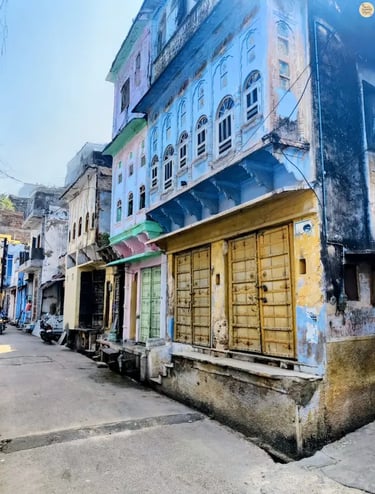

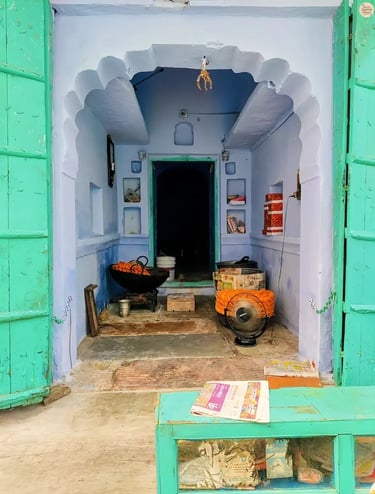

Heritage town of Sambhar with old-world architecture and quiet morning charm.
Old-world shop in Sambhar town selling Feeni.
Devyani Kund and Sharmistha Sarovar – Legends in Water
Near the shimmering expanse of Sambhar Salt Lake lie two sacred freshwater bodies: Devyani Kund and Sharmistha Sarovar, often called the “Little Pushkar” for their serene charm. Surrounded by temple complexes and ghats, these kunds offer a tranquil escape from the white salt plains, inviting pilgrims and travelers alike to pause, reflect, and breathe in the quiet.
Steeped in the Mahabharata legend, Devyani Kund is where Devyani, daughter of sage Shukracharya, married King Yayati. Her friend Sharmistha, daughter of the Daitya King Vrishparva, was also married to Yayati, and their son Puru is said to be the ancestor of the Jat clan. Sharmistha Sarovar, standing in her honor, mirrors these timeless tales of love, loyalty, and lineage, its calm waters holding centuries of story.
Both kunds are considered sacred, their freshwater contrasting sharply against the saline lake nearby. Visiting them, you can feel history and mythology reflected in still waters, a quiet reminder of the legends that have shaped the land around Sambhar Lake for millennia.

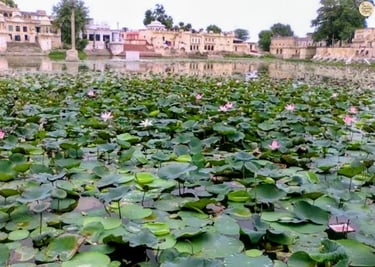
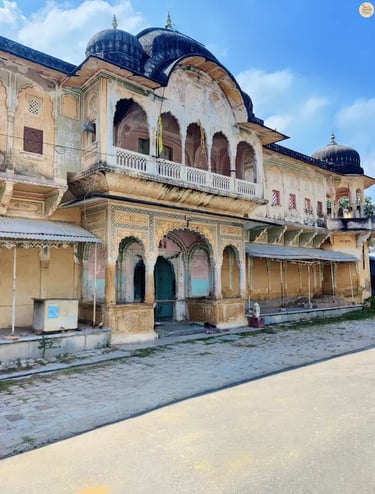

Timeless temple standing gracefully by the tranquil Devyani Kund.
Lotus blooming at Devyani Kund, the “Little Pushkar” of Sambhar.
Naliasar – Echoes of the Past
Just 4 km south of Sambhar town lies Naliasar, an archaeological treasure that whispers stories of ancient settlements. Excavations here have revealed terracotta figurines, coins, and seals, pointing to well-planned communities dating back to the Kushan and Gupta periods.
The sculptural art of Naliasar reflects strong Buddhist influences, highlighting the rich cultural exchanges of the time. Many of these delicate and intricate pieces now reside in the Albert Hall Museum, Jaipur, preserving Sambhar’s deep connection to India’s ancient artistic heritage.
Visiting Naliasar offers a quiet journey into the past — a gentle reminder that even amidst the white plains and salt flats of Sambhar, history has left its enduring mark, waiting to be discovered by travelers who wander with curiosity.
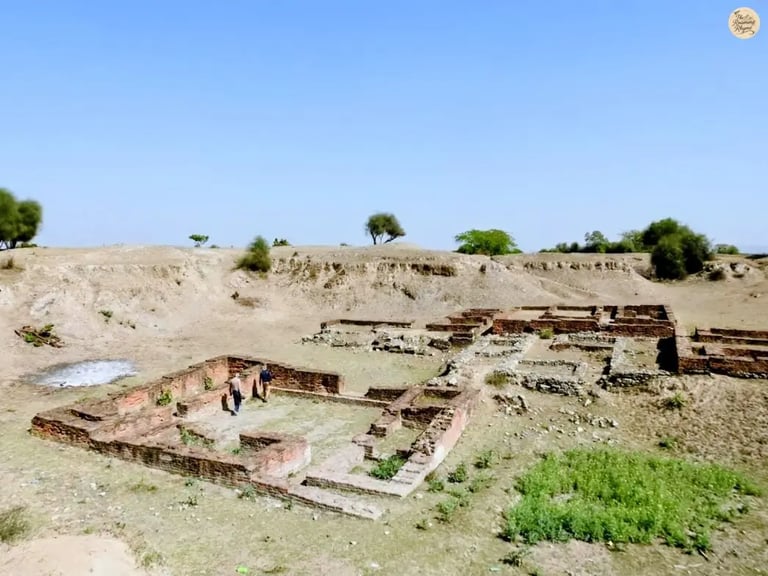

Archaeological site of Naliasar near Sambhar Salt Lake, revealing traces of lost settlements.
Sambhar Salt Lake is more than a destination — it’s a journey where time slows, and every step feels like walking through a living painting. From the pink dance of flamingos across the salt flats to the whispers of history at Shakhambari Devi Temple, Devyani Kund, Sharmistha Sarovar, and Naliasar, this land hums with stories of faith, legend, and craft.
Perfectly located just a couple of hours from Jaipur, Ajmer, and Pushkar, Sambhar makes for an ideal one-day excursion. For travelers from Delhi NCR, it’s a serene weekend getaway, offering a mix of adventure, heritage, and surreal landscapes all in one stop.
Whether you wander through the heritage town, savor the crisp sweetness of Feeni, ride the narrow-gauge trolley across silver plains, or camp under a sky full of stars, Sambhar invites you to lose yourself and find wonder in every reflection. The white salt, endless horizon, and desert wind leave a quiet imprint — a memory that lingers long after you leave, calling you back to trace the paths unknown.
Frequently Asked Questions – Sambhar Lake Travel Guide
Q. Why is Sambhar Lake famous?
A. Sambhar Lake is famous for being India’s largest inland saltwater lake and a major hub for salt production. It’s also known for its stunning salt plains, scenic sunsets, and as a winter haven for migratory birds like flamingos.
Q. Is Sambhar Lake natural or man-made?
A. Sambhar Lake is a natural lake formed through geological processes. It’s fed by several rivers, though human salt production activity often makes it appear partly man-made.
Q. Is Sambhar Lake worth visiting?
A. Yes, definitely. The vast white salt desert, mirror-like water reflections, and flocks of flamingos make it a must-visit for photographers, nature lovers, and travelers seeking offbeat destinations near Jaipur.
Q. What is the difference between Sambhar Lake and Chilika Lake?
A. Sambhar Lake is an inland saltwater lake in Rajasthan, while Chilika Lake in Odisha is a coastal lagoon connected to the Bay of Bengal.
Q. What is the best time to visit Sambhar Lake?
A. The best time to visit is from November to March, when the weather is pleasant and migratory birds arrive, making it ideal for birdwatching and photography.
Q. When can we see flamingos in Sambhar Lake?
A. Flamingos visit Sambhar Lake mainly between November and March, though their stay may vary depending on water levels and food availability.
Q. What is the Sambhar Festival, and where does it take place?
A. The Sambhar Festival is a five-day annual event celebrating Rajasthan’s culture and landscape. It’s held at Sambhar Lake and features folk music, camel safaris, adventure sports, and local cuisine.
Q. How far is Sambhar Lake from Jaipur?
A. Sambhar Lake is about 70 km from Jaipur by road — roughly a 1.5-hour drive.
Q. What are the best things to do around Sambhar Lake?
A. Explore the Salt Pans and Ancient Salt Museum, visit the Shakambhari Devi Temple, enjoy Birdwatching, take photos at sunset, and witness the salt-making process.
Q. How can I reach Sambhar Lake?
A. You can reach Sambhar Lake by road from Jaipur (70 km) or Ajmer (95 km). The nearest railway station is Sambhar Lake. Taxis and local buses are easily available.
Share Your Thoughts – We’d Love to Hear From You!
Every journey is better when shared.
We hope you enjoyed this travel story — now, we'd love to hear yours! Share your experience, suggestions, or feedback and help us make our travel tales even better.
